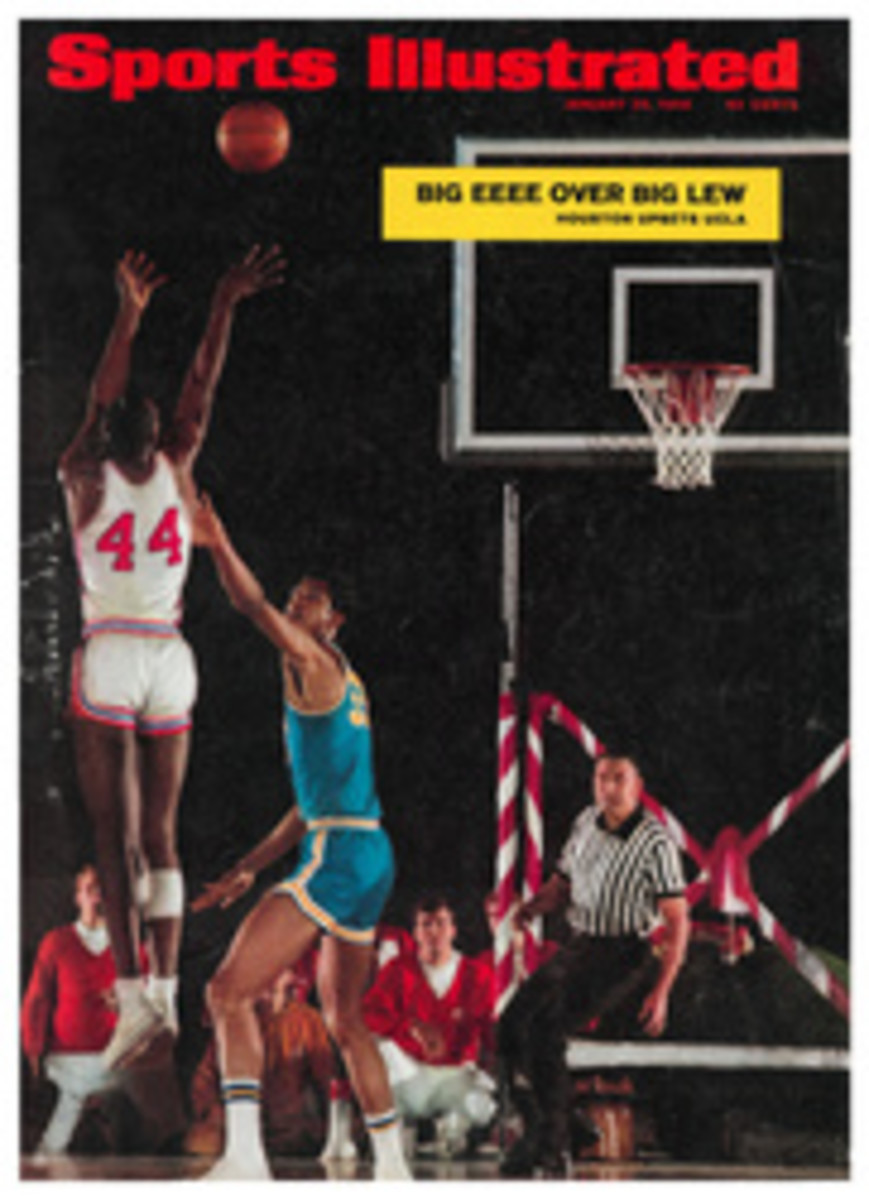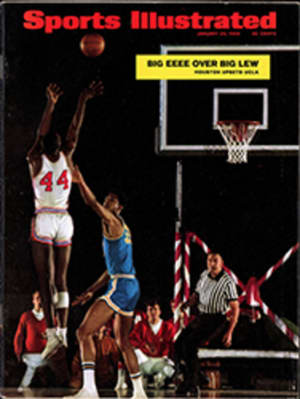
BOLD BOURKEY FOR JOHN MISHA
A little bit of Vince Lombardi is all right, but what this country really needs now and then is a culturally jazzy event like the U.S. Figure Skating Championships, which were held last weekend in Philadelphia. The best of America's most esoteric group of athletes got together and fought it out on the far fringes of sport, and after a season full of the crack of helmets against kidney pads it was a refreshing change. Let's hear it for competitors with guts enough to take on all comers to the tune of something like the Grand Pas Classique.
There they were, bounding around, whirling, slashing, flying off the ice into the rafters of the Spectrum, maybe the only athletes in the world who suit up in sequins, spangles and stretch suits. When it was all over on Sunday night 12 survivors of the 138 in the competition got their reward: the chance to represent the U.S. in Olympic figure skating at Grenoble next month.
Beyond that, after the last Lutz had been Lutzed and the final triple Salchow attempted, the championships had produced an astonishing variety of happenings: 1) an Olympic veteran had been forcefully retired by a cyclonic young skater, just like in those old Sonja Henie movies; 2) a record total of 54,678 people whooped it up during the four days of competition—there was a nearly packed house of 14,216 on Saturday night; and 3) the U.S. team suddenly found itself with surprising depth it had never had before.
"The thing is," said Gary Visconti, the defending national champion, who fell to second place in Philadelphia but still won a ticket to France, "that now the Europeans won't know who to watch out for. We've been sending teams with only one or two strong members, but now, boy, we've got a crew where they'll have to watch all of us, because any one of us could sneak off with the whole thing."
Visconti is right. The U.S. has put together an all-star team that will bear close watching. The women will be headed by Peggy Fleming, and anyone who wouldn't watch Peggy is out of his mind, anyway. Behind Peggy are Albertina Noyes and a 14-year-old sprite from Rockford, Ill. named Janet Lynn, and either of them could stop the Olympic show. As for the men, Visconti was edged out of his championship by a supple youngster named Tim Wood, who has been after him for years. And in the struggle for the third and last spot in the men's group, former Olympian and National Champion Scott Ethan Allen was sent down to the farm team—which means the anticlimactic world championships to be held after the Olympics—by a kid from Montana who was the hit of the show. He is a blond 18-year-old who skates with three names and all the cool of a guy who knows he is not going to fall down and shatter. John Misha Petkevich moved up from the fourth-place ranking he had held after the schoolfigures to dominate the free skating, win a surprising third overall and beat out Allen for a place on the Olympic squad. Lest you are not properly impressed, what he did was roughly equivalent to catching and passing Jim Ryun in the homestretch.
Why? Well, figure skating operates on a competitive point system. Under the system, before a gifted skater can haul off and take his competitors apart he must first go through a compulsory series of skating maneuvers known as school figures, which seem designed to prove that he can distinguish the inside edge of a skate blade from the outside edge. Figure skating places an inordinate amount of emphasis on this sort of silly warmup—it counts 60% toward the final score—and it takes precedence over skating freestyle, even though freestyle is what the game is really all about, no matter what the purists tell you. The result of this archaic system is that a good free skater who is bored by the school figures can come out of the preliminaries hopelessly behind, while a fair free skater who is good at compulsory routines can rack up a fierce lead before the finals.
Which brings us back to John Misha Petkevich. Going into Saturday afternoon he had finished his school figures with 70.72 points, 22 ordinals and no chances, a score to which you need pay no attention. The only thing you should know is that Petkevich was fourth. To move past the talented Scott Allen into third place, he had to stage an impossible performance. And he did.
Petkevich is 5'8" and 150 pounds of spring steel and surprises. "I was nervous about this thing all day," he said. "I had planned to try this triple flip about midway in my routine, see? But then I pulled a muscle in my leg, and I decided I better not go for it. So I gave them everything else I had. And suddenly, about three quarters of the way through, I knew I had them, and I just sort of said, Thanks, God, for letting me win,' and went right on skating."
Who needs triple flips? Petkevich came off the ice in one flying thing he calls the Bourkey, after his coach—a jump in which he kicks sideways, whirls, arches and generally hangs around up in the air long enough to wash out a pair of sweat socks. He added some snazzy Salchows, lots of Lutz jumps and a flying split jump that covered half the distance to Pittsburgh. His performance left the old figure-skating pros in tears, though old figure-skating pros have a marked tendency to cry pretty easily. Even so, when it was all over, the audience—not completely sure what it had seen but positive that whatever it was it was historic—gave him a standing ovation. Figure-skating judges make up the far-right wing of sports, but for all their tendencies to be conservative they went slightly wild, too. Four of the judges gave Petkevich 5.9 points, and one gave him a perfect 6, which no American man has received since 1964. Coach Arthur Bourke (whose jump now will become the most widelycopied move in figure skating) gave John Misha a bear hug that was harder than anything else the kid had been through all day.
Petkevich has been coming on unnoticed for years. He won the free-skating event at the pre-Olympics last year in Grenoble (after placing 14th in the school figures), but everyone made the mistake of assuming that it meant little, because not all of skating's hot shots were entered. Petkevich, who has been at this game since he was 2 years old, figured it was time to attack. He did some obligatory work on the compulsory stuff and rebuilt his free-skating routine around Espa√±a Ca√±i—bullfightish music filled with rhythmic, staccato guitars and castanets. He began to work on the secret jumps and, he adds, "that triple flip goes back in for Grenoble."
He was a tough act to follow. Tim Wood, who is more of a perfectionist than a dazzling performer, had come into the finals well up on school points and moved calmly through his free-skating routine to take first place overall. Visconti, who specializes in grandstand finishes, staged the next-best show of the meet with his free-skating routine, including one triple something that started out as a Salchow and ended up in a three-turns-and-a-flashing-smile, as though he had planned it that way all along. Visconti is the Fran Tarkenton of skating. He brings an element of unpasteurized excitement to the sport. For one thing, he has courage to claim that he weighs 120 pounds, which is patently impossible; he is so small that if he were a sports car his roll center would be three feet underground. Yet he shrugs off his flamboyant style. "What the hell else can I do?" he says. "I always have to come from behind, so I always give them everything I've got when I'm outthere. But that's what this sport is all about. It may sound funny, but this sport is tougher than anything else I can think of. Anyone who says we're not athletes ought to try it one time. It takes strength and coordination, but you know what I'm really trying to do? I'm trying to bring some grace to it. I'm trying to be—well—a boy Peggy Fleming. It's tough."
And nobody laughed when he said it.
Champ Fleming, who has similar ideas about skating, has never been stronger or more graceful than she was in Philadelphia. She skated—floated actually—to an easy victory on Saturday night, a 109-pound wisp in an orange costume, and she made it look easy.
"Well, that's the idea," she said. "We have to make it look easy. Yet you have to make like a track star just to get through a number. Listen, all runners have to do is run around the track. We have to work much harder—and do it all in time to music. I don't know, maybe I should start grunting and grinding a little to make this thing look tougher and get more sympathy."
There is no need. Peggy got five 5.9 votes on the technical merit of her program and three 5.9s and two perfect 6s on composition and style, further contributing to skating scoring history. How sympathetic can judges be?
After the girls had finished, Petkevich came back on the ice for an exhibition round. On one flying Russian split jump he took off to what had to be a new height-and-distance record for figure skaters, finally came back down to the ice and brought the crowd roaring to its feet all over again. "The crowd really turns me on," he chortled afterwards. "Before today's events I was all set not to get to see Grenoble. But now I'm ready. I'm really ready to go."
And he won't need a plane. He could jump that far.
PHOTO

